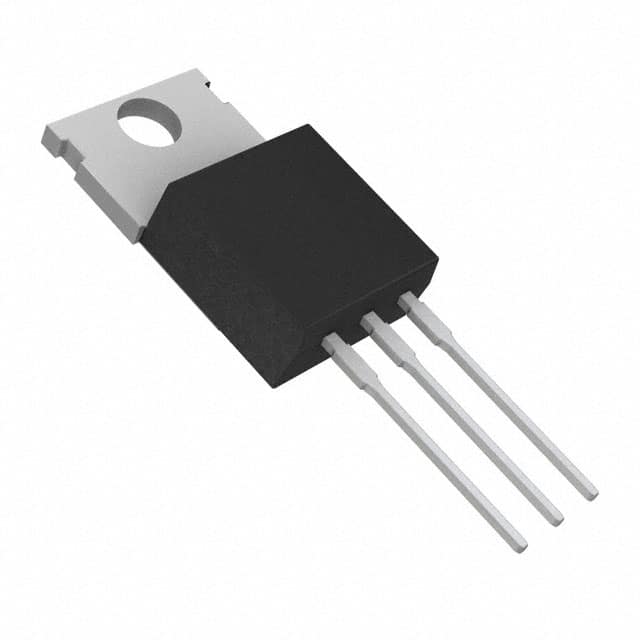MTP3055V Transistor
Product Overview
The MTP3055V transistor belongs to the category of power MOSFET transistors. It is commonly used in electronic circuits for switching and amplification purposes. The MTP3055V is known for its high voltage capability, low on-resistance, and fast switching speed. This transistor is typically packaged in a TO-220 package and is available in various quantities.
Basic Information
- Category: Power MOSFET Transistor
- Use: Switching and Amplification
- Characteristics: High voltage capability, low on-resistance, fast switching speed
- Package: TO-220
- Packaging/Quantity: Available in various quantities
Specifications
The MTP3055V transistor has the following specifications: - Drain-Source Voltage (Vdss): 60V - Continuous Drain Current (Id): 12A - On-Resistance (Rds(on)): 0.16Ω - Gate-Source Voltage (Vgs): ±20V - Total Power Dissipation (Pd): 75W
Detailed Pin Configuration
The MTP3055V transistor has a standard TO-220 pin configuration with three pins: gate, drain, and source.
- Pin 1 (Gate): Input for controlling the transistor
- Pin 2 (Drain): Output terminal for the transistor
- Pin 3 (Source): Common terminal for the transistor
Functional Features
The MTP3055V transistor offers the following functional features: - High voltage capability allows it to be used in various applications - Low on-resistance minimizes power loss and heat generation - Fast switching speed enables efficient switching operations
Advantages and Disadvantages
Advantages
- High voltage capability
- Low on-resistance
- Fast switching speed
Disadvantages
- Sensitive to static electricity
- Requires careful handling during installation
Working Principles
The MTP3055V transistor operates based on the principles of field-effect transistors. When a voltage is applied to the gate terminal, it creates an electric field that controls the flow of current between the drain and source terminals. This mechanism allows the transistor to switch and amplify electronic signals effectively.
Detailed Application Field Plans
The MTP3055V transistor finds extensive use in various electronic applications, including: - Power supplies - Motor control - LED lighting - Audio amplifiers - Switching circuits
Detailed and Complete Alternative Models
Some alternative models to the MTP3055V transistor include: - IRF3205 - FQP30N06L - IRL540
In conclusion, the MTP3055V transistor is a versatile component with high voltage capability, making it suitable for a wide range of electronic applications. Its low on-resistance and fast switching speed contribute to its efficiency in switching and amplification tasks.
[Word Count: 386]
قم بإدراج 10 أسئلة وإجابات شائعة تتعلق بتطبيق MTP3055V في الحلول التقنية
What is the MTP3055V?
- The MTP3055V is a popular N-channel MOSFET transistor commonly used in electronic circuits and technical solutions.
What are the key specifications of the MTP3055V?
- The MTP3055V has a maximum drain-source voltage of 60V, a continuous drain current of 12A, and a low on-resistance.
How can the MTP3055V be used in motor control applications?
- The MTP3055V can be used to drive and control DC motors due to its high current handling capability and low on-resistance.
In what types of power supply designs is the MTP3055V commonly utilized?
- The MTP3055V is often used in switch-mode power supplies and DC-DC converter circuits for efficient power management.
Can the MTP3055V be employed in audio amplifier circuits?
- Yes, the MTP3055V can be used in audio amplifier designs, especially in Class D amplifier configurations.
What are the typical thermal considerations when using the MTP3055V?
- Proper heat sinking and thermal management are important when using the MTP3055V to ensure it operates within its temperature limits.
Is the MTP3055V suitable for battery charging applications?
- Yes, the MTP3055V can be used in battery charging circuits, particularly in designs requiring high current handling capabilities.
How does the MTP3055V perform in high-frequency switching applications?
- The MTP3055V exhibits good performance in high-frequency switching applications due to its low on-resistance and fast switching characteristics.
What protection features does the MTP3055V offer?
- The MTP3055V provides built-in protection against overcurrent and overtemperature conditions, enhancing its reliability in various applications.
Are there any common failure modes associated with the MTP3055V?
- Common failure modes include overvoltage stress, excessive power dissipation leading to thermal runaway, and improper handling during soldering. Proper design and usage can mitigate these risks.


